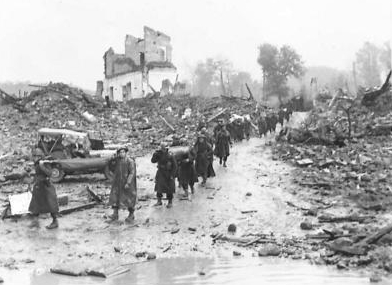Our Monitors Help the Land Fighting in Italy
The War Illustrated, Volume 7, No. 171, Page 488, January 7, 1944.
Seldom in the news, but doing a magnificent and highly important job, the Navy's monitors are specialized warships with a single purpose – the smashing of land targets. How these vessels, armed with 15-in. and smaller guns but not equipped to fight other warships, carry out their great task is described by ALEXANDER DILKE.
In the Italian campaign monitors have come into their own. Geography dictated that much of the fighting should take place on the coastal plains; where that is the case, monitors are able to bring their 15-in. guns to bear on vital targets in the enemy lines and well behind them. How many of these specialized warships are now engaged must remain a secret. The only name which may be mentioned at present is H.M.S. Roberts.
But it is no secret to the Germans that the devastating shells from the batteries of these ships played a decisive part in the critical battle of Salerno when the whole fate of the Italian invasion hung in the balance. While the guns of the destroyers steaming close to the shore engaged the German tanks trying to sally out of the ravines, the heavier guns of the monitors and battleships were ranged on the German heavy batteries farther inland, and on German communications and similar targets. Wherever the fighting goes in the "leg" of Italy, the monitors will find targets. There is no other part of Europe where this type of warship could be used over such a long period.
The monitor is a specialized warship with a single purpose – the bombardment of shore targets. It is not equipped to fight other warships, and Allied naval supremacy is a condition for it going into action. It is defensively armed, and able to take punishment, but otherwise everything is subordinated to the two great guns in a forward turret which are characteristic of its design. Its shallow draught enables it to approach closer to the shore than a battleship with a comparable armament, and its guns are mounted so that they can fire at a high angle, with a maximum range of 40,000 yards. At the long ranges, the shell plunges on its target almost vertically, doing greater destruction to land targets than a shell fired at a low elevation, and having a more demoralizing effect, since the shell gives no audible warning of its approach.
Of the ability of the monitor, with its extensive torpedo bulges, to take punishment, the case of H.M.S. Terror it the classic. When bombarding German positions on the Belgian Coast in the last war she was hit by three torpedoes simultaneously. She reached port, and was back again in a few weeks bombarding the same targets. The Germans had to wait nearly 25 years to get her. She was sunk in February 1941 off the North African coast, but only after three bombs and two mines had broken her back.
H.M.S. Terror played a considerable part in the first Libyan campaign, where she was part of the "Inshore Squadron" to which General Wavell alloted such a generous share of the victory. When war broke out she was in the Far East, but was brought to the Mediterranean. Her first task was one very much out of the line of a monitor – anti-aircraft defence of Malta in the first weeks of the war with Italy, when no other defence was possible. She survived further bombardments in Suda Bay, was attacked by E-boats while bombarding Sidi Barrani in the opening stages of the campaign, and then incessantly attacked from the air.
But the Germans did not get her until she had poured hundreds of rounds into vital targets behind the enemy lines, playing a big part in turning defeat into rout. Whenever the enemy showed signs of stubborn resistance along the coastal road, as at Bardia and Tobruk, the guns of the Terror ranged on them and helped them to change their minds.
Enemy aircraft, made such a dead-set for her that, in the absence of an air "umbrella", her end at some time was almost inevitable. It came through a near-miss from a bomb off Benghazi. She tried to make Tobruk, but two mines flooded more compartments, and another near-miss flooded her engine compartment and she had to be abandoned. Thus ended a great career, in which her guns had pumped hundreds of tons of high explosive on the enemy in two wars.
The work of H.M.S. Roberts in recent months has been equally devastating. She followed the enemy all the way up the east coast of Sicily, remaining in action for ten weeks, with only two days on which the crews were not closed up at action stations. Her most spectacular feat, perhaps, was blocking the road at Taormina. A few well-directed shells started a landslide of rock which completely blocked the road and railway in the enemy's rear. On another occasion a single shell completely destroyed a chemical factory, and a salvo on Spaccaformo, twelve miles inland, was sufficient to force the garrison, which had been putting up a hot resistance, to surrender. There were many instances of enemy batteries being put out of action or coming out to surrender after one or two near misses.
Monitors are equipped with elaborate ranging apparatus, but wireless and the new style of amphibious operations have opened up fresh possibilities to them. In Italy they have been working with the aid of observers on the land as well as with "spotting planes". They are thus able to fire at targets completely out of sight with great accuracy, and even to fire through a smoke-screen.
At the opening of the present war, as at the beginning of the last, the Royal Navy was poorly provided with monitors, but, chiefly under the inspiration of Lord Fisher, sixteen were built in record time, of which H.M.S. Terror and H.M.S. Erebus became the most famous. The latter, incidentally, survived a devastating blow amidships by a small boat laden with high explosive. Four were sunk in operations, and all the rest but three were scrapped during the period of disarmament. Of these three, one became the hulk Drake, at Plymouth, her guns being mounted on H.M.S. Erebus.
Those scrapped monitors would be worth almost their weight in gold in the amphibious warfare we are now undertaking, but their places have been taken by new vessels to an extent which must remain secret. One of the difficulties in building monitors is that the huge guns with their accompanying ranging apparatus cannot be produced in a day or even a few weeks. It is a lengthy and highly specialized job for which only a few establishments are equipped.
A monitor has a remarkably shallow draught – perhaps 11 feet, compared with 27-28 feet of a battleship carrying comparable guns. Her armour is generally limited to about 4 inches, with heavier armour on the gunhouse. The Royal Navy is now the only one to possess monitors. This is in accordance with a long tradition of amphibious warfare. The monitor as a type dates back to the 17th century, but the name itself comes from the famous "Monitor" built by Ericsson for the Federals in the U.S. Civil War.
The duel between the Monitor, which was virtually a floating 11-in. gun battery, heavily armoured, and the Merrimac, built by the Confederates, is a classic of naval history. It was indecisive, in a sense, since neither ship was sunk, but it established the turret mounting of heavy guns and led to the construction of "monitors" along very different lines from those of the "bomb ketches" of the 17th century. The United States did not continue the construction of monitors after the 1914-18 war, presumably not envisaging amphibious warfare under conditions when they would be effective – as now.
Index
Previous article
I Was There! - I Left My Pots and Pans and Downed a Bomber!
Ship's cook, Petty Officer J. H. Hubbard, of the cruiser Aurora on service in the Mediterranean, had already been mentioned in dispatches when he achieved the further distinction of shooting down a Ge
Next article
I Was There! - Men, Mules and Mud I Saw on Monte Camino
One of the key heights on the road to Rome, Monte Camino enemy positions were broken into by the 5th Army by December 7, 1943. War Correspondent Alexander Clifford described appalling conditions maste





